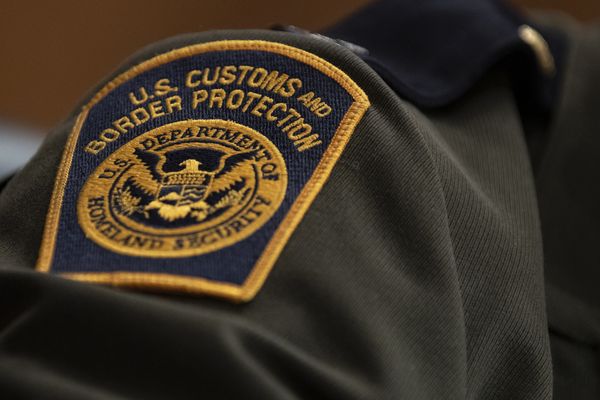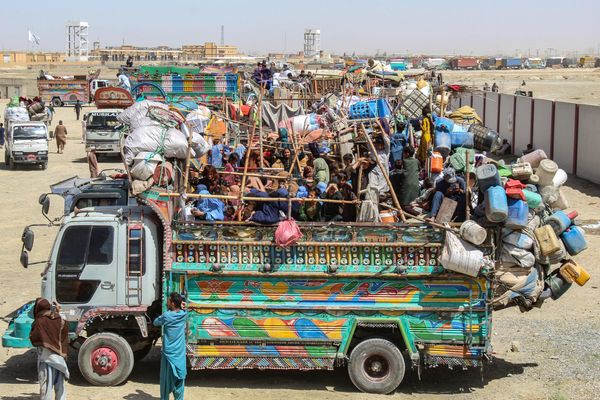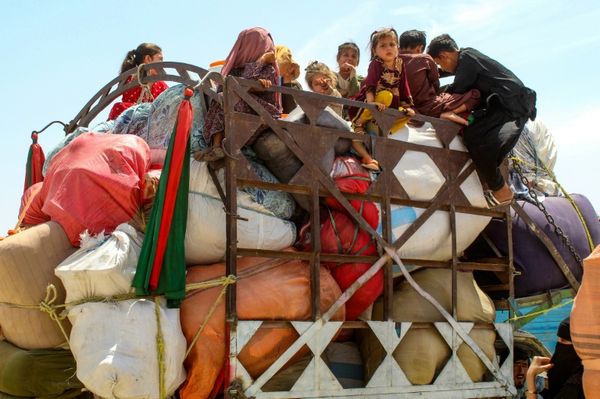
At the Joda border crossing between Sudan and South Sudan, movement is constant. Just 100 metres separate the two border checkpoints – on the Sudanese side, three raised flags welcome newcomers; on the South Sudanese side, a sign in Arabic and English marks the entrance to the country.
Women arrive carrying their children, with their belongings balanced on their heads. Some families bring bed frames, nightstands, food, chairs and suitcases, loading them on to carts pulled by donkeys and crossing into South Sudan to escape war in Sudan.
“Today, I feel like I am in a safe place,” says Hamed Attaher, a 26-year-old technology student from the University of Khartoum. Attaher has been travelling since he left Khartoum a year ago, and has finally set foot on South Sudanese soil. “My aunt is waiting for me in Juba,” he says.
The entry point for refugees from Sudan to South Sudan; in the background is the border. In December, more than 5,000 people crossed this point each day
The world’s youngest country is facing the most severe humanitarian crisis in the world as thousands of displaced people continue to cross the border into South Sudan’s Upper Nile state at the Joda border, 30 miles (50km) north of the town of Renk. More than 12.5 million people in Sudan have been forced to flee their homes since the war broke out in April 2023. During the first weeks of December, at least 5,000 people crossed into South Sudan each day, fleeing bombing and fighting between the Sudanese Armed Forces (SAF) and the Rapid Support Forces (RSF).
At a checkpoint on the crossing, the International Organization for Migration (IOM) categorises people as either refugees or “returnees”. For many, arriving in South Sudan means returning to a land they thought they would never see again after fleeing the civil war that began in 2013 – these are the returnees.
Left: A group of women board an IOM bus to be transferred to the town of Renk; right: a sack of USAid sorghum alongside a pile of belongings
Now, it is the South Sudanese who are receiving their neighbours and, in some cases, their former compatriots. “We are one people because we call the Sudanese side ‘North Juba’ and the South Sudanese side ‘South Juba’,” says a humanitarian worker, though officially the area is called Wunthou.
In the reception area, UNHCR tents provide shade and BP-5, emergency food for disaster relief, for those waiting to continue their journey to reunite with family or friends.
For those with health problems, the IOM handles “green” patients, meaning those who can wait, while Médecins Sans Frontiers (MSF) takes care of the “orange” and “red” cases. Today, an ambulance evacuated a five-month-old baby weighing only 2.5kg to Renk County hospital for urgent medical care.
Aid workers lift a young child on to one of the trucks taking people displaced by the war in Sudan to the town of Renk in South Sudan
Some people choose to continue their journey on their own, heading to the informal settlements that have sprung up along the road between Joda and Renk, near the White Nile River. These makeshift communities grow each day, with small businesses, improvised mosques and new neighbourhoods taking shape. Others opt for the buses and trucks to nearby towns organised by the IOM.
Attaher has climbed into one of these trucks along with dozens of men, women and children. He waves, making a victory sign with his hand as he begins what he hopes will be the final leg of his journey.
***
At Renk County hospital, where those needing immediate care are taken, baby Hosseini is lying in a bed in the paediatric section. His twin sister, Hasana, occupies another bed in the intensive care unit. Hosseini was the first to be born, weighing just 1.4kg; Hasana weighed 1.2kg.
A doctor from MSF visits patients in the paediatric tent outside Renk hospital. Fourteen tents have been erected in the hospital’s grounds to make space for an influx of war-wounded patients
The 25-day-old twins were born here in Gosfami, one of the informal settlements in Renk County, which is home to thousands of displaced people who have fled the war in Sudan in recent months. The twins’ mother, Bakhita, 22, gave birth when she was just seven months pregnant. “Thank God they were born in South Sudan,” she says.
About 110,000 people have arrived in Renk County since December, according to MSF data, with 70,000 living in informal settlements such as Gosfami where there is little food or water. Fourteen tents were placed in the grounds of the hospital in Renk to make space for the influx of war-wounded patients, according to MSF.
“Here, we treat Sudanese refugees, the local population and South Sudanese returnees,” says Atem Deng Ajak, an MSF doctor.
Bakhita, who is in the paediatric tent of Renk hospital with her 25-day-old premature twins, Hosseini and Hasana
Also in the paediatric tent is Amna, 35, who is making a plastic doll dance to distract her infant son, Aron. They have fled the city of Sennar, in Sudan’s Blue Nile State, and now live in Gosfami. She struggles to remember the name of her village. “The SAF and the RSF started fighting, so we took a donkey and a cart and left. We walked for 20 days until we reached safety,” she says.
MSF’s Rachel Daniel works in the psychological support tent, where children are playing with a green balloon. “We talk to mothers with children in intensive care, and we also deal with the trauma of war – many cannot sleep,” Daniel says. The cry of a mother interrupts her. She is coming from the intensive care unit and Daniel embraces her from behind and leads her into the white tent, decorated with drawings, carpets and toys. “I don’t know what’s happening, maybe she lost someone,” says one of Daniel’s colleagues.
Children play in MSF’s psychological support tent
In front of the psychological support tent, a little girl struggles to blow up a balloon. She sits on a chair beneath a porch made of wooden logs. It is the cooking area for the women accompanying sick and injured children. The smell of incense fills the air. A pot of tea is heated on a metal oil canister with the letters of USAid on it, now repurposed as a charcoal stove.
More than half of South Sudan’s humanitarian budget comes from USAid and the freeze on funds imposed by Donald Trump is a fresh blow to the situation in South Sudan.
A teapot on top of a stove made out of a repurposed USAid oil can
The transportation service at the border had to halt operations for several days after Trump’s executive order. “Other services [on the border], like information teams for displaced people or psychological support, have also been suspended,” says a humanitarian worker who prefers to remain anonymous.
Inside the hospital, Ajak is focused on doing what he can to help Bakhita and her young family. “We are feeding the twins’ mother so she can produce milk, but in the end, only God can help us,” he says.







